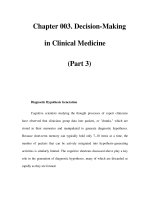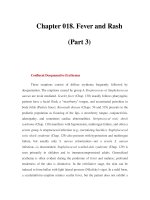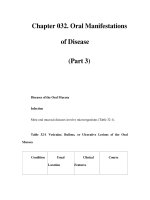Chapter 117. Health Advice for International Travel (Part 3) potx
Bạn đang xem bản rút gọn của tài liệu. Xem và tải ngay bản đầy đủ của tài liệu tại đây (14.71 KB, 5 trang )
Chapter 117. Health Advice for
International Travel
(Part 3)
Rabies
Domestic animals, primarily dogs, are the major transmitters of rabies in
developing countries (Chap. 188). Several studies have shown that the risk of
rabies posed by a dog bite in an endemic area translates into 1–3.6 cases per 1000
travelers per month of stay. Countries where canine rabies is highly endemic
include Mexico, the Philippines, Sri Lanka, India, Thailand, and Vietnam. The
three vaccines available in the United States provide >90% protection. Rabies
vaccine is recommended for long-stay travelers, particularly children, and persons
who may be occupationally exposed to rabies in endemic areas. Even after receipt
of a preexposure rabies vaccine series, two postexposure doses are required.
Travelers who have had the preexposure series will not require rabies immune
globulin (which is often unavailable in developing countries) if they are exposed
to the disease.
Prevention of Malaria and Other Insect-Borne Diseases
It is estimated that more than 30,000 American and European travelers
develop malaria each year (Chap. 203). The risk to travelers is highest in Oceania
and sub-Saharan Africa (estimated at 1:5 and 1:50 per month of stay, respectively,
among persons not using chemoprophylaxis); intermediate in malarious areas on
the Indian subcontinent and in Southeast Asia (1:250–1:1000 per month); and low
in South and Central America (1:2500–1:10,000 per month). Of the more than
1000 cases of malaria reported annually in the United States, 90% of those due to
Plasmodium falciparum occur in travelers returning or immigrating from Africa
and Oceania. VFRs are at the highest risk of acquiring malaria. With the
worldwide increase in chloroquine- and multidrug-resistant falciparum malaria,
decisions about chemoprophylaxis have become more difficult. In addition, the
spread of malaria due to primaquine- and chloroquine-resistant strains of
Plasmodium vivax has added to the complexity of treatment. The case-fatality rate
of falciparum malaria in the United States is 4%; however, in only one-third of
patients who die is the diagnosis of malaria considered before death.
Several studies indicate that fewer than 50% of travelers adhere to basic
recommendations for malaria prevention. Keys to the prevention of malaria
include both personal protection measures against mosquito bites (especially
between dusk and dawn) and malaria chemoprophylaxis. The former measures
include the use of DEET-containing insect repellents, permethrin-impregnated
bed-nets and clothing, screened sleeping accommodations, and protective clothing.
A new insect repellent containing picaridin as an active ingredient appears to be
quite efficacious and is available in the United States only in low-concentration
formulations that require frequent reapplications. Thus, in regions where
infections such as malaria are transmitted, DEET products (25–50%) are
recommended, even for children and infants >2 months of age. Personal protection
measures also help prevent other insect-transmitted illnesses, such as dengue fever
(Chap. 189). Over the past decade, the incidence of dengue has increased,
particularly in the Caribbean region, Latin America, and Southeast Asia. Dengue
virus is transmitted by an urban-dwelling mosquito that bites primarily at dawn
and dusk.
Table 117-2 lists the currently recommended drugs of choice for
prophylaxis of malaria, by destination.
Table 117-
2 Malaria Chemosuppressive Regimens According to
Geographic Area
a
Geographic Area
Drug of
Choice
Alternatives
Central
America (north
of Panama), Haiti, Dominican
Republic, Iraq, Egypt, Turkey,
northern Argentina, and
Paraguay
Chloroquine Mefloquine
Doxycycline
Atovaquone/proguanil
South America
including Panama (except
northern Argentina and
Paraguay); Asia (including
S
outheast Asia); Africa; and
Oceania
Mefloquine
Doxycycline
Atovaquone-
proguanil (Malarone)
Primaquine
Thai-
Myanmar and
Thai-Cambodian borders
Doxycycline
Atovaquone-
proguanil (Malarone)
a
See CDC's Health Information for International Travel 2005–2006.
Note: See also Chap. 203.









